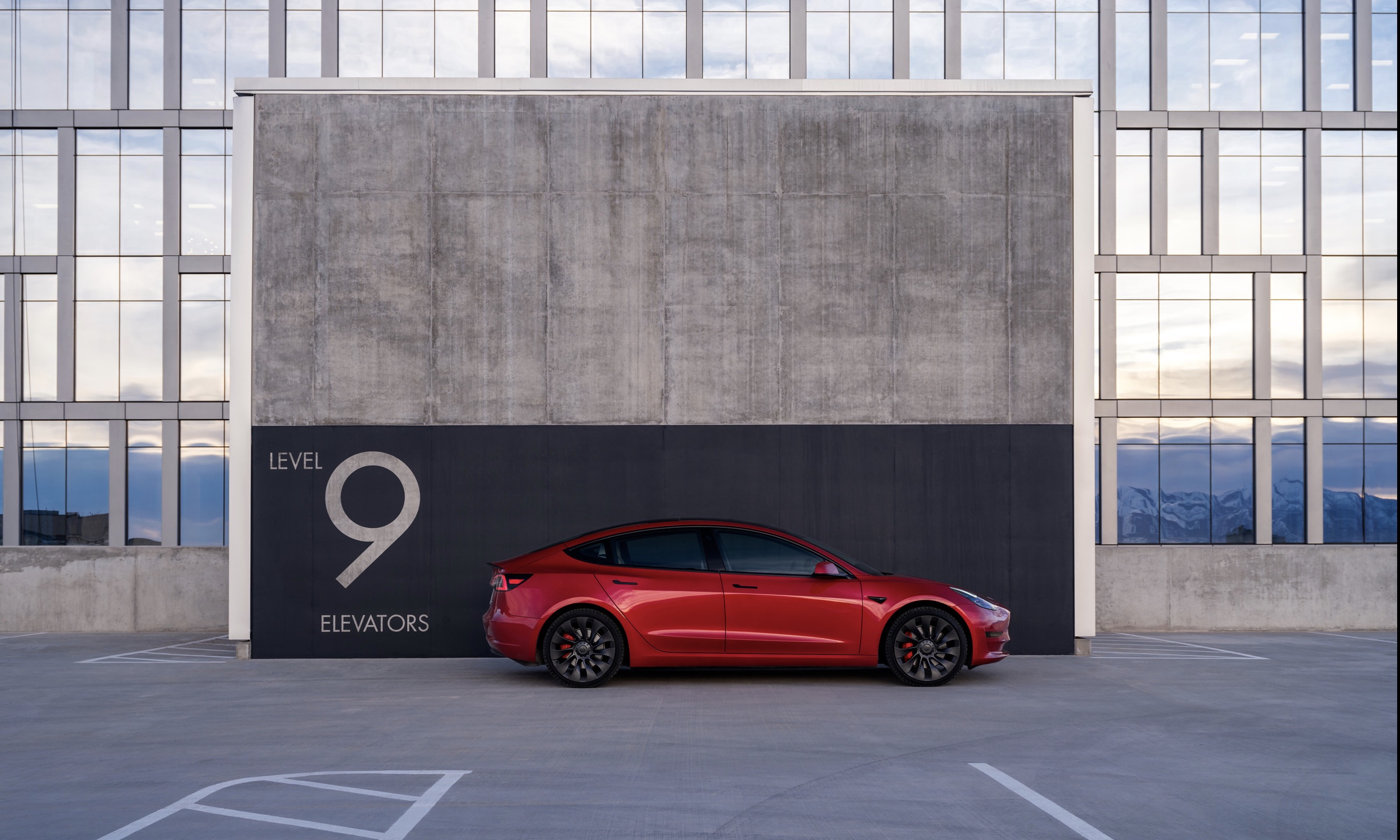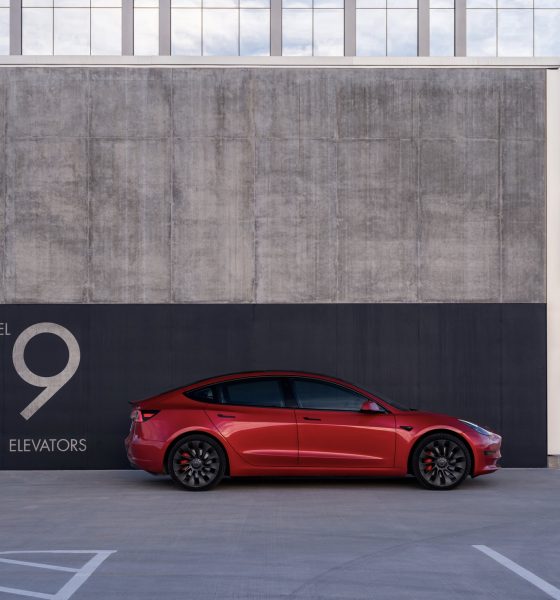The Tesla Model 3 has made it onto a list of the top 10 most-leased vehicles in the U.S., becoming the first electric vehicle (EV) to do so.
According to new Experian data in a report from Automotive News, Tesla’s Model 3 sedan became the seventh-most commonly leased vehicle in the U.S. in the second quarter. Demand for the electric sedan was largely propelled by price cuts and EV tax credits. At the top of the list were the Ford F-150, the Honda CR-V and the Nissan Rogue.
The Model 3 accounted for just 1.79 percent of new vehicles that were leased in the quarter, and as many as one in four Model 3 sales were on lease for a 14-point increase from last year’s Q2. The top three leasing vehicles, the F-150, CR-V and Rogue, made up a combined share of 7.26 percent of all new leased vehicles.
Credit: Automotive News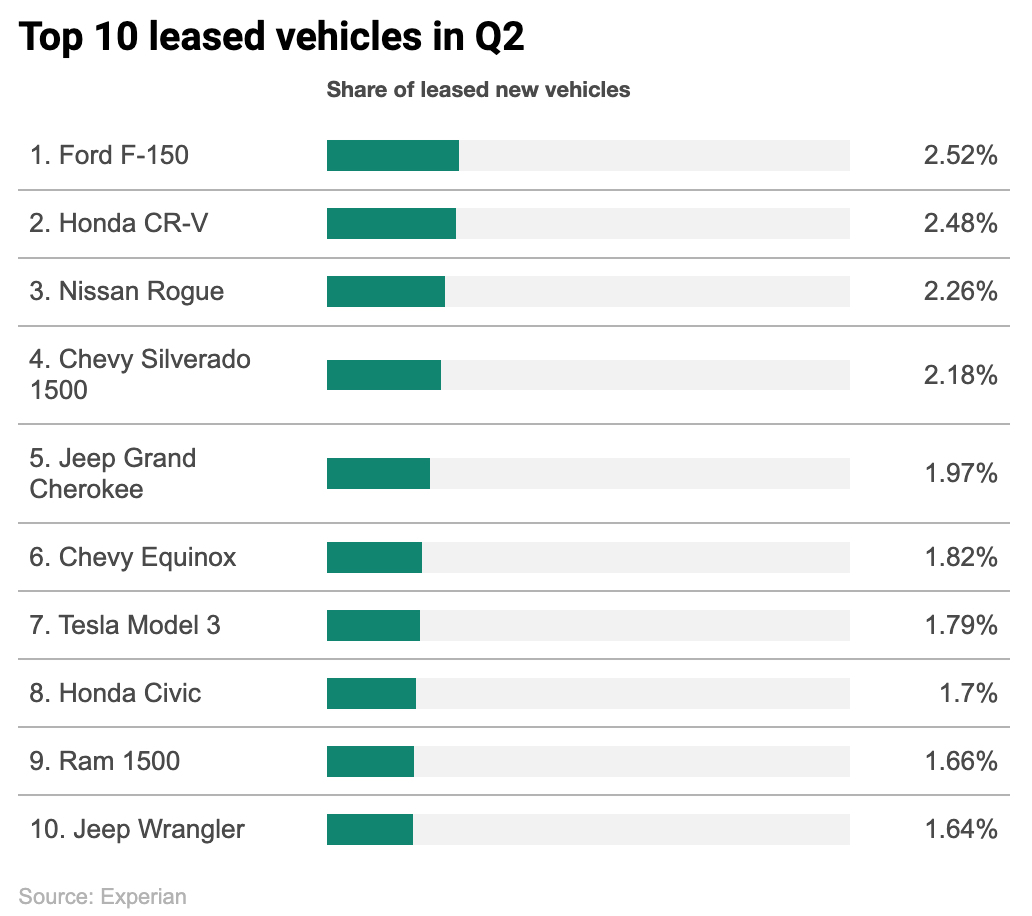
Melinda Zabritski, senior director of automotive financial solutions at Experian, says it isn’t typical for a car like the Model 3 to make this list, adding that it’s usually comprised of higher-volume vehicles with leases.
“In the EV space, there is so much change and so many new models coming out that leasing can be a good way to have the vehicle for a short period of time,” Zabritski said. “An EV lease is a great way to avoid any of those ownership concerns that consumers might have.”
According to Automotive News, the leasing rate for the Model 3 surpassed the overall new vehicle lease rate of 21.3 percent, as well as the EV lease rate, which landed at roughly 21.2 percent. Zabritski notes that current lease rates are still far below peak levels achieved in 2018 and 2019 when the overall leasing rate jumped over 30 percent.
The news of the Model 3’s inclusion on the most leased vehicles comes as Tesla prepares a $1.8 billion lease securitization process this week. The process will entail Tesla bundling up several of its auto leases to be sold off as bonds, generating an alternative source of funding without the automaker needing to wait until lease money trickles in.
Some think that Tesla may also use the funding to create even shorter-term leases than it currently offers.
Earlier this year, Tesla also debuted a new seven-year financing option in addition to its three-, four-, five- and six-year leases.
What are your thoughts? Let me know at zach@teslarati.com, find me on X at @zacharyvisconti, or send your tips to us at tips@teslarati.com.

News
Tesla hosts Rome Mayor for first Italian FSD Supervised road demo
The event marked the first time an Italian mayor tested the advanced driver-assistance system in person in Rome’s urban streets.
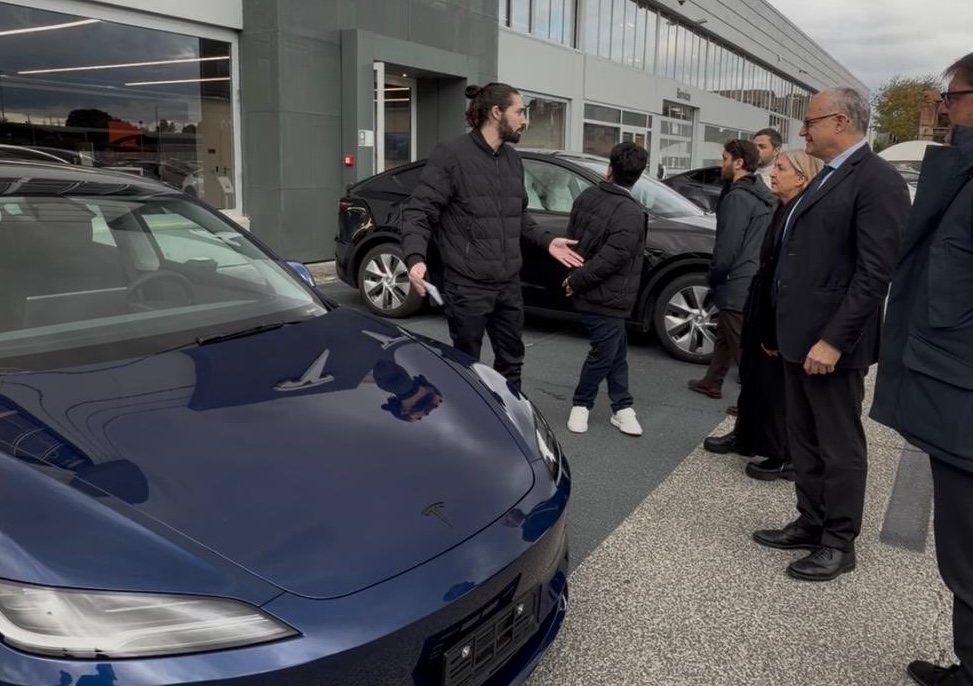
Tesla definitely seems to be actively engaging European officials on FSD’s capabilities, with the company hosting Rome Mayor Roberto Gualtieri and Mobility Assessor Eugenio Patanè for a hands-on road demonstration.
The event marked the first time an Italian mayor tested the advanced driver-assistance system in person in Rome’s urban streets. This comes amid Tesla’s push for FSD’s EU regulatory approvals in the coming year.
Rome officials experience FSD Supervised
Tesla conducted the demo using a Model 3 equipped with Full Self-Driving (Supervised), tackling typical Roman traffic including complex intersections, roundabouts, pedestrian crossings and mixed users like cars, bikes and scooters.
The system showcased AI-based assisted driving, prioritizing safety while maintaining flow. FSD also handled overtakes and lane decisions, though with constant driver supervision.
Investor Andrea Stroppa detailed the event on X, noting the system’s potential to reduce severe collision risks by up to seven times compared to traditional driving, based on Tesla’s data from billions of global fleet miles. The session highlighted FSD’s role as an assistance tool in its Supervised form, not a replacement, with the driver fully responsible at all times.
Path to European rollout
Tesla has logged over 1 million kilometers of testing across 17 European countries, including Italy, to refine FSD for local conditions. The fact that Rome officials personally tested FSD Supervised bodes well for the program’s approval, as it suggests that key individuals are closely watching Tesla’s efforts and innovations.
Assessor Patanè also highlighted the administration’s interest in technologies that boost road safety and urban travel quality, viewing them as aids for both private and public transport while respecting rules.
Replies on X urged involving Italy’s Transport Ministry to speed approvals, with one user noting, “Great idea to involve the mayor! It would be necessary to involve components of the Ministry of Transport and the government as soon as possible: it’s they who can accelerate the approval of FSD in Italy.”
News
Tesla FSD (Supervised) blows away French journalist after test ride
Cadot described FSD as “mind-blowing,” both for the safety of the vehicle’s driving and the “humanity” of its driving behaviors.
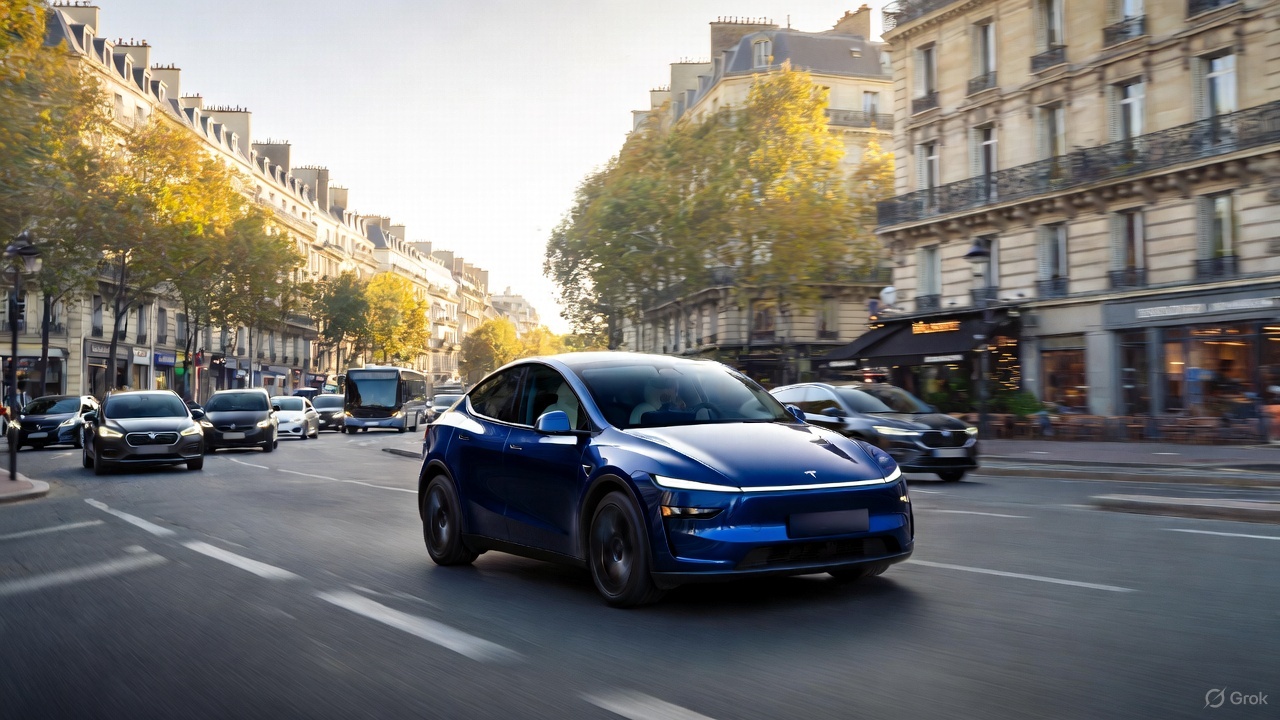
Tesla’s Full Self-Driving (Supervised) seems to be making waves in Europe, with French tech journalist Julien Cadot recently sharing a positive first-hand experience from a supervised test drive in France.
Cadot, who tested the system for Numerama after eight years of anticipation since early Autopilot trials, described FSD as “mind-blowing,” both for the safety of the vehicle’s driving and the “humanity” of its driving behaviors.
Julien Cadot’s FSD test in France
Cadot announced his upcoming test on X, writing in French: “I’m going to test Tesla’s FSD for Numerama in France. 8 years I’ve been waiting to relive the sensations of our very first contact with the unbridled Autopilot of the 2016s.” He followed up shortly after with an initial reaction, writing: “I don’t want to spoil too much because as media we were allowed to film everything and I have a huge video coming… But: it’s mind-blowing! Both for safety and for the ‘humanity’ of the choices.”
His later posts detailed FSD’s specific maneuvers that he found particularly compelling. These include the vehicle safely overtaking a delivery truck by inches, something Cadot said he personally would avoid to protect his rims, but FSD handled flawlessly. He also praised FSD’s cyclist overtakes, as the system always maintained the required 1.5-meter distance by encroaching on the opposite lane when clear. Ultimately, Cadot noted FSD’s decision-making prioritized safety and advancement, which is pretty remarkable.
FSD’s ‘human’ edge over Autopilot
When asked if FSD felt light-years ahead of standard Autopilot, Cadot replied: “It’s incomparable, it’s not the same language.” He elaborated on scenarios like bypassing a parked delivery truck across a solid white line, where FSD assessed safety and proceeded just as a human driver might, rather than halting indefinitely. This “humanity” impressed Cadot the most, as it allowed FSD to fluidly navigate real-world chaos like urban Paris traffic.
Tesla is currently hard at work pushing for the rollout of FSD to several European countries. Recent reports have revealed that Tesla has received approval to operate 19 FSD test vehicles on Spain’s roads, though this number could increase as the program develops. As per the Dirección General de Tráfico (DGT), Tesla would be able to operate its FSD fleet on any national route across Spain. Recent job openings also hint at Tesla starting FSD tests in Austria. Apart from this, the company is also holding FSD demonstrations in Germany, France, and Italy.
Elon Musk
Tesla Optimus shows off its newest capability as progress accelerates

Tesla Optimus showed off its newest capability as progress on the project continues to accelerate toward an ultimate goal of mass production in the coming years.
Tesla is still developing Optimus and preparing for the first stages of mass production, where units would be sold and shipped to customers. CEO Elon Musk has always marketed the humanoid robot as the biggest product in history, even outside of Tesla, but of all time.
He believes it will eliminate the need to manually perform monotonous tasks, like cleaning, mowing the lawn, and folding laundry.
However, lately, Musk has revealed even bigger plans for Optimus, including the ability to relieve humans of work entirely within the next 20 years.
JUST IN: Elon Musk says working will be ‘optional’ in less than 20 years because of AI and robotics. pic.twitter.com/l3S5kl5HBB
— Watcher.Guru (@WatcherGuru) November 30, 2025
Development at Tesla’s Artificial Intelligence and Robotics teams has progressed, and a new video was shown of the robot taking a light jog with what appeared to be some pretty natural form:
Just set a new PR in the lab pic.twitter.com/8kJ2om7uV7
— Tesla Optimus (@Tesla_Optimus) December 2, 2025
Optimus has also made several public appearances lately, including one at the Neural Information Processing Systems, or NeurIPS Conference. Some spectators shared videos of Optimus’s charging rig, as well as its movements and capabilities, most interestingly, the hand:
You have to hand it to Elon 🤟 pic.twitter.com/fZKDlmGAbe
— Ric Burton · NeurIPS 2025 (@_ricburton) December 2, 2025
The hand, forearm, and fingers have been one of the most evident challenges for Tesla in recent times, especially as it continues to work on its 3rd Generation iteration of Optimus.
Musk said during the Q3 Earnings Call:
“I don’t want to downplay the difficulty, but it’s an incredibly difficult thing, especially to create a hand that is as dexterous and capable as the human hand, which is incredible. The human hand is an incredible thing. The more you study the human hand, the more incredible you realize it is, and why you need four fingers and a thumb, why the fingers have certain degrees of freedom, why the various muscles are of different strengths, and fingers are of different lengths. It turns out that those are all there for a reason.”
The interesting part of the Optimus program so far is the fact that Tesla has made a lot of progress with other portions of the project, like movement, for example, which appears to have come a long way.
However, without a functional hand and fingers, Optimus could be rendered relatively useless, so it is evident that it has to figure this crucial part out first.
